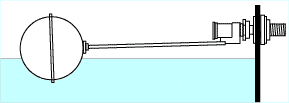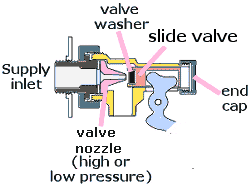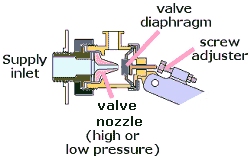Ball (or float) valves
 One method of controlling the flow of water into water tanks and cisterns is the use of ball valves.
One method of controlling the flow of water into water tanks and cisterns is the use of ball valves.
Simply, a 'ball' floating on the water inside the tank/cistern moves an arm attached to the valve which controls the input of water. As the ball/arm falls, the valve is opened to allow water into the tank, then as the water level rises, so does the ball and arm closing off the valve.
Note that although referred to here as a 'ball', the float can be any shape - non-spherical floats will be found in narrow cisterns where space is limited.
The point at which the valve is closed (thus setting the level of the water) can be adjusted by the arm attached to the float, the method of adjustment depends on the type. The three basic set-ups are:
- The most common arrangement is where there is a solid brass rod between the valve and ball; in this case, the rod needs to be physically bent. To do this, firmly grip the rod in both hands, hold the hand next to the valve still (so as not to put any pressure onto the valve) and use the other hand to bend the rod a small amount, up to increase the water level or down to lower it.
- On other systems there is a hinge in the arm between the valve and the ball with a lock nut and adjustment screw - to adjust just loosen off the lock nut and adjust the hinge to bend the hinge.
- The other set-up used has an adjustable screw at the valve end of the arm (normally with a lock nut), release the lock nut and adjust the screw as necessary.
The two common types of valve mechanism are the slide (or piston) valve and the diaphragm valve.
Both types use a valve nozzle to reduce the flow into the valve, there are two style of valve, high and low pressure (some valves are supplied with both, one fitted and the other supplied in the bag). The high pressure valve nozzle (the one with the smaller feed hole) needs to be fitted where the tank is fed direct from the water main, the low pressure valve nozzle is fitted where the tank is fed from a water tank. If a high pressure nozzle is incorrectly fitted in a tank fed system, the tank will take a long time to fill up. If a low pressure nozzle is fitted in a main fed system, the valve may not close property causing leaks into the cistern/tank. At the time of installation the correct supply valve nozzle must be fitted.
The slide valve
 A typical slide valve is shown in cross-section to the right.
A typical slide valve is shown in cross-section to the right.
As the float arm moves up and down with the water level in the cistern/tank, the cam on the end of the arm inside the slide valve body slides the piston towards or away from the feed hole through the middle of the valve nozzle. When the level of the water is at the correct level, the valve washer is forced against the nozzle hole and the water supply is shut off.
As the water in the cistern/tank drops, the slide valve is moved back allow water to enter the tank to fill it up.
In the past, the outlet from slide valves were often fitted with a 'silent feed' pipe (a short pipe from the valve down into the water in the cistern/tank). As the water was fed from the valve into the cistern/tank below the water level, there was reduced noise of water filling the tank. These pipes are now banned (due to the risk of water being drawn back from the tank in the event of mains pressure failure) and if fitted, these pipes should be removed and discarded.
These valves are very robust and reliable. Modern slide valves may be made from plastic and these do not suffer so much as the brass ones from deposit build up or corrosion.
Wear in these valves are not normally a problem, the valve washer may need replacement, especially if the supply water contains muck etc. Other than that, there's not much else to go wrong.
The diaphragm valve
 The diaphragm valve operates with an arm from the float as for the slide valve but in this case a screw adjuster on the top of the arm pushes against a 'plunger' which pushes the diaphragm against the supply valve nozzle.
The diaphragm valve operates with an arm from the float as for the slide valve but in this case a screw adjuster on the top of the arm pushes against a 'plunger' which pushes the diaphragm against the supply valve nozzle.
One 'reputed' advantage of the diaphragm valve is that the only moving part which is in contact with the water is the diaphragm itself, and that this reduces problems in hard water areas where deposit build-up and corrosion can occur.
Like with the slide valve, in the past, the outlet from diaphragm valves were often fitted with a 'silent feed' pipe so that the water was fed from the valve into the storage tank below the water level; these pipes are now banned (due to the risk of water being drawn back from the tank in the event of mains pressure failure) and, if fitted, should be removed and discarded.
